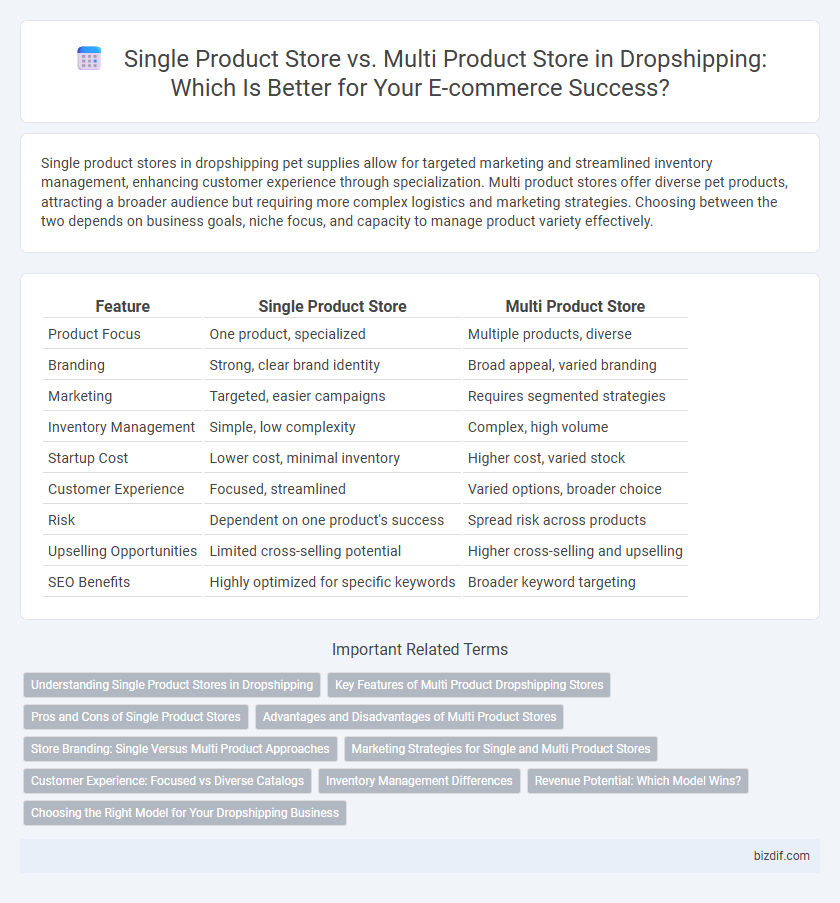Single product stores in dropshipping pet supplies allow for targeted marketing and streamlined inventory management, enhancing customer experience through specialization. Multi product stores offer diverse pet products, attracting a broader audience but requiring more complex logistics and marketing strategies. Choosing between the two depends on business goals, niche focus, and capacity to manage product variety effectively.
Table of Comparison
| Feature | Single Product Store | Multi Product Store |
|---|---|---|
| Product Focus | One product, specialized | Multiple products, diverse |
| Branding | Strong, clear brand identity | Broad appeal, varied branding |
| Marketing | Targeted, easier campaigns | Requires segmented strategies |
| Inventory Management | Simple, low complexity | Complex, high volume |
| Startup Cost | Lower cost, minimal inventory | Higher cost, varied stock |
| Customer Experience | Focused, streamlined | Varied options, broader choice |
| Risk | Dependent on one product's success | Spread risk across products |
| Upselling Opportunities | Limited cross-selling potential | Higher cross-selling and upselling |
| SEO Benefits | Highly optimized for specific keywords | Broader keyword targeting |
Understanding Single Product Stores in Dropshipping
Single product stores in dropshipping focus exclusively on one niche item, allowing for targeted marketing and brand identity development. This approach enhances customer experience by providing in-depth information, specialized content, and tailored promotions for the single product. By concentrating efforts on one product, businesses can optimize ad spend, simplify inventory management, and increase conversion rates compared to multi product stores.
Key Features of Multi Product Dropshipping Stores
Multi product dropshipping stores offer extensive product variety, catering to broader customer segments and improving cross-selling opportunities. These stores leverage diversified suppliers, reducing dependency risks and enabling seamless inventory management across multiple niches. Advanced analytics tools help optimize product performance, pricing strategies, and marketing campaigns efficiently within multi product dropshipping environments.
Pros and Cons of Single Product Stores
Single Product Stores excel in streamlined branding and targeted marketing, leading to higher conversion rates and simplified inventory management. However, they face limitations in diversification, making them vulnerable to market fluctuations and limited customer reach compared to Multi Product Stores. Businesses must weigh the benefits of focused niche appeal against the risks of reduced product variety when choosing a single product dropshipping model.
Advantages and Disadvantages of Multi Product Stores
Multi product stores in dropshipping offer a broader market reach by catering to diverse customer needs, increasing potential sales volume and reducing dependency on a single product's performance. Managing multiple products requires advanced inventory tracking, higher marketing costs, and complex customer support, which can lead to operational challenges and diluted brand identity. However, the diversification lowers business risks associated with changing market trends or product seasonality, enhancing long-term stability.
Store Branding: Single Versus Multi Product Approaches
Single product stores offer a focused branding strategy by highlighting one key item, making it easier to create a strong, memorable identity that resonates with a specific target audience. Multi product stores provide a broader appeal with diverse offerings, allowing for cross-selling opportunities but often diluting brand clarity and customer perception. Effective store branding hinges on whether a niche-focused single product or a diverse catalog better aligns with the long-term business goals and market positioning.
Marketing Strategies for Single and Multi Product Stores
Single product stores benefit from laser-focused marketing strategies, allowing for precise audience targeting and tailored ad creatives that emphasize the unique value proposition of the product. Multi product stores require diversified marketing campaigns that segment audiences based on varied product categories, leveraging cross-selling and upselling tactics to maximize average order value. Both approaches demand data-driven optimization, but single product stores often achieve higher conversion rates through niche specialization, while multi product stores prioritize broader reach and customer retention.
Customer Experience: Focused vs Diverse Catalogs
Single product stores offer a focused customer experience by specializing in one item, which simplifies decision-making and often leads to higher conversion rates. Multi product stores provide a diverse catalog that attracts a broader audience with varied preferences, enhancing the chances of cross-selling and repeat purchases. Choosing between these models depends on whether the goal is depth of expertise or breadth of product variety to optimize customer satisfaction.
Inventory Management Differences
Single Product Stores simplify inventory management by focusing on a limited range of items, reducing stock tracking errors and streamlining supplier coordination. Multi Product Stores require more complex inventory systems to handle diverse SKUs, increasing the need for automated tools to prevent stockouts and overstock situations. Efficient inventory management in both models directly impacts order fulfillment speed and customer satisfaction.
Revenue Potential: Which Model Wins?
Single Product Stores often generate higher revenue per visitor due to focused marketing, streamlined inventory, and stronger brand identity, leading to better conversion rates. Multi Product Stores diversify revenue streams by appealing to broader audiences and cross-selling opportunities, but may dilute the marketing impact and increase operational complexity. Considering average order value, conversion rate, and customer acquisition cost, Single Product Stores typically dominate in revenue potential for niche markets while Multi Product Stores excel in long-term scalability and market reach.
Choosing the Right Model for Your Dropshipping Business
Selecting the right model between a single product store and a multi product store depends on your target market focus and inventory management preferences. Single product stores enable focused marketing efforts and higher conversion rates by specializing in one niche item, while multi product stores offer broader customer appeal and diversification but require more complex logistics. Analyzing your budget, niche knowledge, and scalability goals ensures the best fit for sustainable dropshipping success.
Single Product Store vs Multi Product Store Infographic

 bizdif.com
bizdif.com